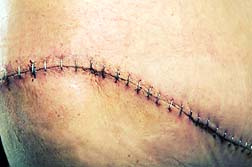 External pain pumps have been around for a while and were developed in tandem with the rise in arthroscopic surgery. The latter has been both an aid to hospitals, which helps to free up beds—and for patients, given the more rapid recovery times for less-invasive surgery.
External pain pumps have been around for a while and were developed in tandem with the rise in arthroscopic surgery. The latter has been both an aid to hospitals, which helps to free up beds—and for patients, given the more rapid recovery times for less-invasive surgery.The problem: oral pain medications. Given the often-intense pain associated with shoulder surgery, doctors found themselves prescribing some pretty potent pain meds in order to combat the intense discomfort. In a hospital setting, the monitoring of oral pain medication was never a problem.
However, with the advent of arthroscopic surgery and the capacity to have a shoulder injury treated arthroscopically at a clinic during a same-day procedure, doctors were understandably reluctant to send powerful pain medication home with the patient where proper monitoring would not be possible.
Enter the external pain pump, which delivers controlled pain medication to the wound site via a catheter that is inserted through the arthroscopic incision.
If you are continuing to have shoulder problems after routine shoulder surgery and an external shoulder pain pump was used during your recovery to deliver pain medication, read this next part very carefully…
Shoulder pain pumps were fine when the tip of the catheter insert stopped at soft tissue. But pain pump manufacturers allegedly wanted to expand the use—and thus, their market for the units by introducing pain medication directly to the shoulder joint.
They sought approval from the US Food and Drug Administration (FDA), but were turned down: not once, but numerous times (reuters.com 01/12/09).
According to sources, shoulder pain pump manufactures continued to promote the use of the pain pump directly to the shoulder joint to doctors, who had every reason to believe that the procedure was safe and appropriate. However, no known testing on the part of the manufacturers had been done.
Undaunted, the use of the shoulder pain pump for the delivery of pain medication to the shoulder joint continued for some time, until post-operative shoulder issues began cropping up. Patients were requiring second surgeries and on occasion complete shoulder replacement surgery, at considerable expense.
Incredibly, doctors were finding that the cartilage in the shoulder joints, separating the bones, was breaking down and dying—even in relatively young people.
Here's why: it was determined that the pain medication used proved toxic to shoulder cartilage. Even a shoulder pain pump used for just 2, or 3 days is enough to expose the cartilage to enough toxicity for it to degenerate, or die.
The condition is known as post arthroscopic glenohumeral chondrolysis (PAGCL) and is characterized by the breaking down of the cartilage between the bones. This material, vital to pain-free joint movement and mobility, does not regenerate or grow back. Once it is compromised or gone, that's it.
READ MORE PAIN PUMP LEGAL NEWS
Some patients have even lost their arm entirely. Most face a lifetime of pain.
The sad part is that even young people, who injure a shoulder playing college football for example, now face a lifetime of pain and limited mobility as the result of having been prescribed a shoulder pain pump that was never approved by the FDA for use directly to the shoulder joint.
That's why there are more than 100 lawsuits across the US, with more in the works. Shoulder pain pump manufacturers are alleged to have promoted, on a widespread basis the shoulder pain pump for a use that was never approved by the FDA.
That's a serious allegation—but so too is the impact that constant pain and lack of mobility may have on a life, on a career.
